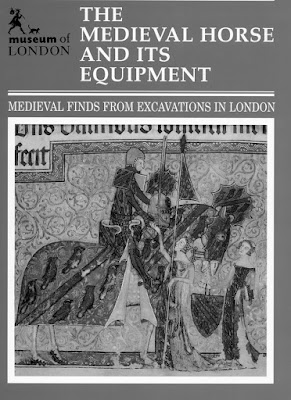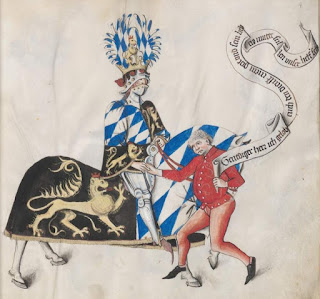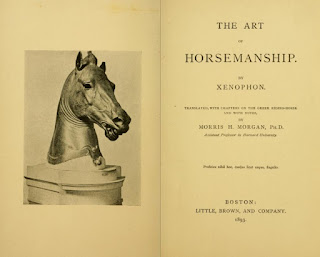Saturday, April 30, 2016
Hans Thalhofer, Fechtbuch von 1467
Hans Thalhofer
Fechtbuch von 1467 - BSB Cod.icon. 394 a
Hans Talhoffer (Dalhover, Talhouer, Thalhoffer, Talhofer) was a 15th century German fencing master. His martial lineage is unknown, but his writings make it clear that he had some connection to the tradition of Johannes Liechtenauer, the grand master of the German school of fencing. Talhoffer was a well educated man, who took interest in astrology, mathematics, onomastics, and the auctoritas and the ratio. He authored at least five fencing manuals during the course of his career, and appears to have made his living teaching, including training people for trial by combat.
excerpt from: http://wiktenauer.com/wiki/Hans_Talhoffer
These images are just a few taken from the section on "Mounted Sword Play".
Illuminating the Medieval Hunt
Illuminating the Medieval Hunt features nearly fifty miniatures from the Morgan's celebrated hunting manuscript by Gaston Phoebus (1331–1391), Le Livre de la chasse (Paris, ca. 1407). Since the manuscript was disbound—for reasons of conservation and the preparation of a facsimile—the exhibition provides a unique opportunity for the public to "walk" through the manuscript as well as to turn the pages of the facsimile. The miniatures illustrate the four books of the treatise, which deal with gentle and wild animals, the nature and care of dogs, instructions on hunting with dogs, and the use of various snares and crossbows by hunters.
A rare first edition of Le Livre de la chasse (ca. 1507) is also on view as well as the Book of St. Albans, the first English book (1486) on hunting. In addition, a dozen manuscripts illustrate how the medieval hunt was used as a metaphor in both sacred and profane texts. To show that the noble hunt was not limited to Europe, the exhibition ends with six examples of Islamic and Indian origin.
Excerpt from :
The Morgan Library and Museum: 225 Madison Avenue at 36th Street, New York, NY 10016
http://www.themorgan.org/exhibitions/illuminating-the-medieval-hunt
The Medieval Horse and its Equipment, c.1150-1450
The Medieval Horse and its Equipment, c.1150-1450 (Medieval Finds from Excavations in London) (Volume 5)
This is a basic work of reference for archaeologists and those studying medieval artifacts.
"Over 400 recent finds associated with horses and excavated in London, from the utilitarian to the highly decorated, illustrated and discussed. Whether knight's charger or beast of burden, horses played a vital role in medieval life.
The wealth of medieval finds excavated in London in recent years has, not surprisingly, included many objects associated with horses. This catalogue illustrates and discusses over four hundred such objects, among them harness, horseshoes, spurs and curry combs, from the utilitarian to highly decorative pieces. London served by horse traffic comes vividly in view."
 |
| click image to read as .pdf |
Gervase Markham, A Discource of Horsmanshippe
Markham, Gervase, 1568?-1637
Online link and references here
A discource of horsmanshippe Wherein the breeding and ryding of horses for seruice, in a breefe manner is more methodically sette downe then hath been heeretofore.
With a more easie and direct course for the ignorant, to attaine to the same arte or knowledge. Also the manner to chuse, trayne, ryde and dyet, both hunting-horses, and running-horses: with all the secretes thereto belonging discouered. An arte neuer heeretofore written by any authour.
At London: Printed by I. C[harlewood] for Richard Smith, and are to be sold at his shoppe at the West-doore of Poules, Anno. Dom. 1593.
Ann Arbor, MI ; Oxford (UK) :: Text Creation Partnership,
2003-05 (EEBO-TCP Phase 1)
To the extent possible under law, the Text Creation Partnership has waived all copyright and related or neighboring rights to this keyboarded and encoded edition of the work described above, according to the terms of the CC0 1.0 Public Domain Dedication (http://creativecommons.org/publicdomain/zero/1.0/). This waiver does not extend to any page images or other supplementary files associated with this work, which may be protected by copyright or other license restrictions. Please go to http://www.textcreationpartnership.org/ for more information.
The Art of Horsemanship, by Xenophon
by Xenophon; Morgan, M. H.
(Morris Hicky), 1859-1910
This translated Version Published 1893
Veterinary Library's copy part of the John A. Seaverns
Equine Collection
Publisher Boston, Mass. : Little, Brown, and Co.
Pages 224
Possible copyright status NOT_IN_COPYRIGHT
Language English
Call number 19347510
Digitizing sponsor Tufts University
Book contributor Webster Family Library of Veterinary
Medicine
Collection websterfamilyvetmed; blc; americana
Among the earliest known works on choosing, caring for, and riding horses, this book is still hailed--2,300 years after it was written — as one of the most complete, thoughtful, and accessible guides of its type. Civilization has changed radically in the centuries since it was written, but the equestrian arts have remained essentially the same. Much of what we presently accept as common wisdom about horsemanship derives from this volume.
A student of Socrates, Xenophon was an accomplished cavalryman and one of the foremost scholars of his day. This translation by Morris H. Morgan offers a fluid interpretation of the ancient Greek's advice, plus 38 carefully chosen illustrations. Equestrians and other horse lovers as well as military history buffs and students of Greek culture will find The Art of Horsemanship a treasury of practical tips and enlightened observations.

German fencing manual created by Paulus Kal

Paulus Kal
Bavarian State Library - Die Bayerische Staatsbibliothek
This manual has many images and detailed positions for fighting from horseback and from foot.
German fencing manual created by Paulus Kal
The Cgm 1507 is a German fencing manual created by Paulus Kal in ca. 1470. The original currently rests in the holdings of the Bayerische Staatsbibliothek in Munich, Germany. The manuscript is dedicated to Ludwig IX "the Rich" of Wittelsbach (1417-1479), Duke of Bavaria-Landshut. This seems to be the archetype of Paulus Kal's treatise, and the only copy that was certainly commissioned by the master himself.
The manuscript consists of a redaction of some of the teachings of Johannes Liechtenauer on mounted fencing, armored fencing, and unarmored fencing, as well as Kal's own teachings on a variety of other weapons. It differs from the works of other followers of Liechtenauer in that instead of offering extensive glosses of the high master's verse, Kal relies on detailed illustrations.
Despite being the most complete version of Kal's treatise, this manuscript is missing several pages, including two leaves between ff 2 and 3 and one each between 18/19, 79/80, 91/92, and 93/94. The missing folio 18a may have corresponded to the plays on ff 12v - 13r of the MS Chart.B.1021, but any content on the other five folia cannot currently be determined.
Excerpt from: http://wiktenauer.com/wiki/Paulus_Kal_Fechtbuch_(Cgm_1507)
This manual has many images and detailed positions for fighting from horseback and from foot.
The Cgm 1507 is a German fencing manual created by Paulus Kal in ca. 1470. The original currently rests in the holdings of the Bayerische Staatsbibliothek in Munich, Germany. The manuscript is dedicated to Ludwig IX "the Rich" of Wittelsbach (1417-1479), Duke of Bavaria-Landshut. This seems to be the archetype of Paulus Kal's treatise, and the only copy that was certainly commissioned by the master himself.
The manuscript consists of a redaction of some of the teachings of Johannes Liechtenauer on mounted fencing, armored fencing, and unarmored fencing, as well as Kal's own teachings on a variety of other weapons. It differs from the works of other followers of Liechtenauer in that instead of offering extensive glosses of the high master's verse, Kal relies on detailed illustrations.
Despite being the most complete version of Kal's treatise, this manuscript is missing several pages, including two leaves between ff 2 and 3 and one each between 18/19, 79/80, 91/92, and 93/94. The missing folio 18a may have corresponded to the plays on ff 12v - 13r of the MS Chart.B.1021, but any content on the other five folia cannot currently be determined.
Excerpt from: http://wiktenauer.com/wiki/Paulus_Kal_Fechtbuch_(Cgm_1507)
Subscribe to:
Posts (Atom)





